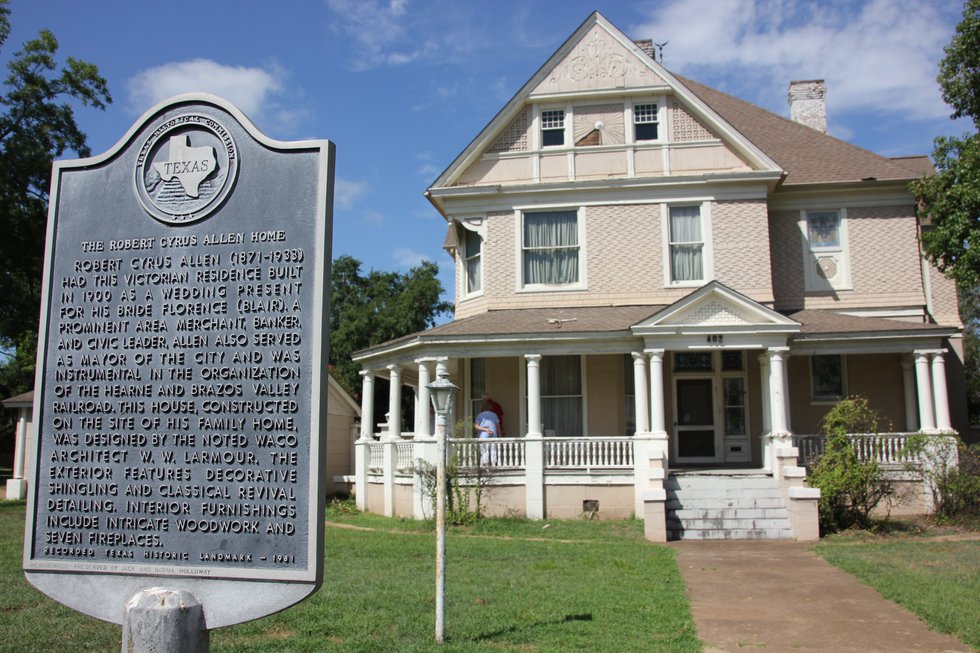Historic houses allow patrons to step back in time with architecture and style that reflect their golden age, capturing the antique charm of its decades-old development. Within historic districts and landmark locations, these homes may share old age but each have their own unique stories.
Local organizations across the Brazos Valley are committed to preserving the architectural integrity and historical significance of these homes. These efforts are more than just about maintaining buildings; they capture the stories, struggles and traditions of those who lived there long ago. From College Station to Calvert, learn about Brazos Valley’s historical preservation efforts and take a trip through time with sneak peeks from local landmarks.
Becoming a Historic Landmark
With historic plaques scattered across the community, these landmarks can be recognized at national, state and local levels. Established in 2021, The Bryan Historic Landmark Commission (HLC) follows a set of specific requirements to determine which locations can be labeled as a historic landmark with an official marker through the Bryan, Texas Landmark Program project.
Benjamin Johnson, staff planner for the City of Bryan’s Development Services works closely with historic districts and buildings to ensure preservation is maintained. Benjamin says the push to preserve historic communities is popular throughout the City of Bryan because of its deep-rooted history.
“There are a couple requirements that historic landmarks in the city have to have,” Benjamin says. “[The location] has to be in the boundaries of a [Historic Preservation Overlay District]. It has to be at least 50 years old [and] be on the national register or a state landmark. There are some requirements, like an application that’s submitted online, which is interpreted by the HLC. Then, final approval is done by the city council.”
The City of Bryan chooses historic landmarks based heavily on storytelling rather than just its age. From nearly-forgotten stories of struggle to long-gone traditions, the significance of historical landmarks lie beyond the physical appearance. As part of the preservation efforts, the Historical Preservation Team share some of these stories online at 150.bryantx.gov/oral-histories.
“Age is important, but it’s not as important as the story behind it,” Benjamin says. “That’s something that the City of Bryan, as a whole, has been pushing a lot when it comes to historic preservation. We want to protect these famous buildings that have been here for such a long time.”
To learn about the City of Bryan’s historical preservation efforts, visit their website at bryantx.gov.
Calling a Historic Landmark “Home”
In the early years of the 20th century, the homes that sat on the same land as Texas A&M University were moved off campus to make room for university growth. While some were burned, demolished or sold, 20 houses were moved to what is now known as College Station’s Southside Historic Neighborhood before the city was even established.
Liana Vincent, head of volunteers for the Southside Historic Neighborhood, organizes committees to welcome new homeowners, offer community events, maintain the neighborhood’s alluring scenery and preserve the historic cluster of homes in College Station.
“The architectural styles that are represented in a historic neighborhood reflect what was going on in the time period that they’re built,” Liana says. “We like to learn a little bit about the people, their stories and the architecture of their home. [The architecture style] kind of reflects what was going on in the world at its original time.”
These homes were formerly owned by professors at Texas A&M, and moved when they wanted their own neighborhood off campus, Liana says.
“Southside is the first and it’s the oldest neighborhood in College Station,” Liana says. “Some of the professors were like, ‘We want to get off campus,’ so they bought some acreage over here. It was called the Southside Development Company. In 1921, they bought 83 acres by the park.”
The neighborhood celebrated its 100-year establishment in 2023 at the Southside Historic Neighborhood Centennial Celebration and purchased updated street signs to reflect the milestone. They invite all residents to participate in organized events on social media platforms.
“Our full-time, and even part-time, residents go and knock on the doors with the students [in the neighborhood] and say welcome for this year,” Liana says. “We just try to get to know everybody’s names and stuff like that to build a sense of community.”
For more information about the Southside Historic Neighborhood, check out their Instagram page @southsidehistoricneighborhood for news, events and historical facts.
Take a Trip through Time
The Robertson County Historical Commission organized by volunteers Rodney and Becky Calloway, Kathy Hedrick and Timothy Wilkins, works to manage the historical preservation throughout the county. With dedication to preservation and historic appreciation, the group orchestrated a comprehensive tour of historic homes throughout Robertson County.
Mikayla Martinez
The Westbrook-Philen-Byrd House
Mikayla Martinez
The Robert Cyrus Allen Home
Mikayla Martinez
The John Henry Gibson House
Mikayla Martinez
The Joseph A. Foster House
Mikayla Martinez
The Rehberg House
The Bremond House
Mikayla Martinez
The Barton House
The Westbrook-Philen-Byrd House has been owned by Janna Byrd and her husband since 1987. The three-story home has been beautifully preserved by the owners to match the time period of its construction, preserving its historical essence.
Moving away from the Houston-area, Janna and her husband were not originally in the market to purchase a historic home, but they have since preserved the time-capsule feeling of the home by hosting regular community and social events, along with their own family celebrations.
“We had horses, and my husband showed horses, so we started looking for a ranch,” Janna says. “My husband originally found a ranch in Madisonville, and I said, ‘I can’t even see a highway. No, I am not a country girl, I want to at least see people go by,’ and we were on our way to meet our realtor when we saw this house.”
A 5 foot by 12 foot table, etched brick fireplace, magnificent woodwork and a lavish staircase are just a few of the features from the original structure that are still present. While carefully renovating the home, Janna searched for decorations that dates back to its establishment in 1904. The years of work Janna dedicated to refurbishing the home emphasizes its centennial beauty inside and out.
The Robert Cyrus Allen Home, once owned by a beloved Hearne local who recently passed, Norma Holloway, dates back to the year 1900. With seven ornate fireplaces, the Victorian home was first built by a former mayor of the City of Hearne as a gift to his wife, Florence Allen.
The home was designed by Waco’s Premier Victorian Architect, W. W. Larmour (1842-1908), and can be identified by its classical revival architecture style with a detailed decorative exterior. It stands next to St. Philips Episocal Church, another registered Texas Historical Landmark.
The John Henry Gibson House, named after the prominent Gibson family of Calvert, was owned by three families before landing in the hands of Elaine Hensarling and her husband in 1994. With a blend of Victorian and Craftsman style, the home features two stories of wrap-around porches and intricate details of woodwork throughout the antique structure.
“In the ladies parlor, I was shopping for old-style wallpaper in Houston,” Elaine says. “We had to move the old mantle out to retile the room, and the wallpaper was pretty much a replica of what the original design looked like.”
In the heart of Calvert, the Joseph A. Foster House is now owned by John O’Donnell who is working diligently to renovate the home. He is the fourth and current owner of the home, purchasing and beginning renovations in 2007. The total renovation is simultaneously modernizing the house while maintaining its originality. To optimize the functionality of the three-story home, it will potentially become a bed-and-breakfast after the renovations. The face of the home reflects the Classical Revival style with an added driveway and columns, combining the home’s past and modern features.
“Because this will be my retirement place, everything is either fiberglass, hard siding [or] concrete for minimal maintenance,” John says. “The style of this house was very popular for an architect by the name of George F. Barber. We looked at all the original blueprints for an ideal new layout that is similar to its old one.”
The Rehberg House, also known as the Rehberg Place Bed & Breakfast, has been renovated and maintained by Nikki and Danny Screws. Originally built in 1910, the home now serves as a bed-and-breakfast and event venue with 5 bedrooms and original antique furniture, including a unique record player.
The Bremond House was purchased by Cindy Murray in 2012, who used to dream of living in the home since she was a child riding her bike on the street. The uniquely painted teal-colored home was built in 1893. The home stands out for its originality, including a trap door and pharmacology equipment from a previous owner that the current family found in the house.
The last of the “big houses” on the Robertson County tour is The Barton House, which was built in 1909 and designed by architect George F. Barber. It was home to a widow and her daughters in its early days, attributing to why the house does not have the traditional men and women’s parlor, just a room adjacent to the entryway designed for the ladies to host social gatherings and needlework sessions. The home has been maintained by its fourth owner since 2004, Ann Satterwhite who worked alongside her husband to renovate the home to match the initial period. The brick Barton House is memorable to guests for its 12-foot-tall ceilings, columned porches and intricate woodworks within its interior.
Ann managed the home’s renovation while being mindful of the living history the home embodies.
“We saw a ‘for sale’ sign and we pictured ourselves having a mint julep on the porch,” Ann says. “I wanted a real living room. We finally came and looked at this house. It has a modern feel.”
For more information, visit the Robertson County Historical Commission on Facebook.



